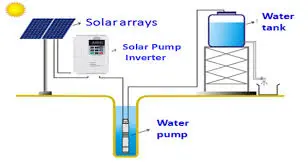"Solar Information Center: A helpful resource for customers seeking information relating to the different solar systems and there various components"
What’s included within a home solar power system?
We supply kits that include everything you need to generate free, renewable energy.
solar power systems include:
- Solar panels and roof mounting kit
- Solar power inverter to convert DC energy from the panels to AC mains current
- All cabling, fixtures and fittings to connect everything together
- Optional batteries and connections to store the energy and charge controller
HOW DO SOLAR PANELS WORK?
Solar panels generate direct-current (DC) electricity when light hits them. Remember, it is the light from the sun that generates the electricity, not the heat. Heat actually reduces the panels’ efficiency, as we’ll learn a little later. How do solar panels generate electricity from light? The light knocks electrons about in the silicon wafers that make up the panels. Those electrons are caught by tiny wires called ‘busbars’, which are laid on the silicon. This process is called the ‘photovoltaic effect’.
Online resource: How the photovoltaic effect works: solarquotes.com.au/pv
AC VS DC CURRENT
The DC power is ‘direct current’, which means it is a steady voltage and current. This voltage can be high: up to 600 V in a residential installation. But the appliances in your home don’t use DC; they use ‘alternating current’ (AC). AC means that the current wiggles up and down 50 times a second. The reason they use AC power is that, at the advent of large-scale electricity generation, AC was much easier to generate. Why? Because all generators were made to spin. For example, a steam turbine uses steam to spin a generator. A spinning generator without any modern power electronics to smooth it naturally generates AC as it spins round.
Also, AC is much easier to put through transformers to jack up the voltage to hundreds of thousands of volts. Then the current can be efficiently transmitted long distances from power stations (or wind farms) to your local substation.
The whole developed world is set up for AC power, so we need to convert the DC solar power to AC power, which is usually 230 V AC, cycling at 50 times a second. That DC to AC conversion is done by the solar inverter. The solar inverter is a box of power electronics that sits on your wall. It converts solar DC to usable AC, which is fed directly into your home’s switchboard.
From the switchboard the solar power will first flow into any appliances in your home that are using power. There will always be some electricity consumption in a modern home, so whenever there is solar generation, at least some of it will flow into the house.
Below are diagram aided illustration of the types of solar system and the components they are made up of;

ON GRID SOLAR SYSTEM
On-grid means your solar system is tied to your local utility’s GRID(ZESCO). On-Grid solar power systems also come with a management system so you can monitor charge, performance and other data. These are often WiFi connected for ease of use. In addition, battery storage will require a charge controller. This manages the charge from the solar panels and ensures batteries are charged evenly and not overcharged, which could damage them. This is a piece of essential equipment and is included with every home solar power system.
OFF GRID SOLAR SYSTEM
Being off-grid means you are not connected in any way to your grid’s power system
or utility company. This is appealing because you are 100% self-sustaining your
energy use. However, there are disadvantages because off-grid systems require you
to purchase back-up battery which can be expensive, bulky, and not very
environmentally friendly which defeats the purpose of going solar (save money and
live greener).

SOLAR PUMP SET-UP

SOLAR PUMP
Water is essential for agriculture, industries, and households. However, many parts of India face acute water shortage issues. Solar-powered water pumps provide a sustainable solution by utilizing renewable solar energy to pump water.
A complete solar pump system consists of the following key equipment:
1. Solar PV panels - To generate electricity to power water pump
2. Pump set - Submersible or surface solar pump to lift and transfer water
3. Controller unit - Controls pump motor speed/flow based on water demand
4. Mounting structure - Holds solar panels in place and tilted at optimum angle
5. Water storage tank - Stores pumped water for later productive use
6. Pipes and valves - Interconnect system components as required
7. Cables and switches - To transfer power and control system
Choosing the Right Solar Pump
With a wide variety of solar pumps available in the market, it is crucial to select the right pump that meets your specific water flow and head requirements.
HYDRID (AC/DC) PUMP
What is AC and DC pump?
AC Solar Submersible Pump sets use alternating current as their power source, which is available on almost every power grid. An inverter can also be used in a situation where the power source is DC. DC Solar Submersible Pump set, on the other hand, require Direct Current to operate, which is derived from solar panels.

What is the difference between solar AC and DC pump?
A DC solar pump is more efficient as it gives maximum output with fewer solar panels. AC solar pumps need more solar panels as the electricity has to be converted into AC for utilization. As a result, the efficiency of the system is reduced in the latter's case.
Both AC and DC Solar Submersible Pump set s have their advantages and disadvantages, depending upon their use. It is recommended that you get in touch with a professional engineer to discuss your requirements and get a recommendation on what pump will suit your needs.